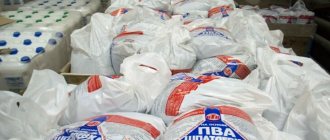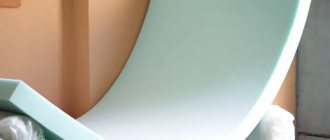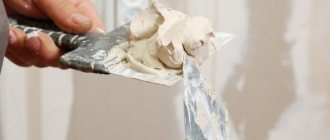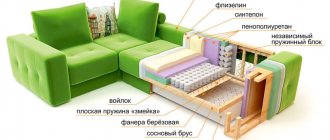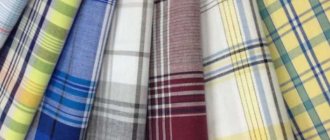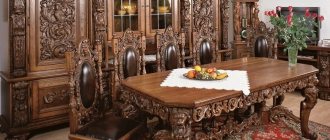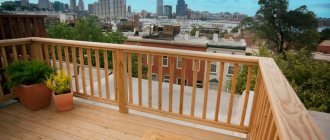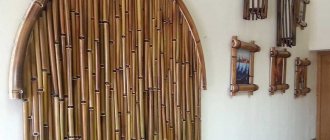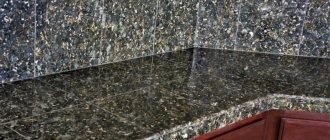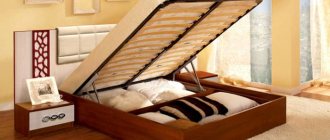Today, putty is the most popular method of finishing walls and load-bearing structures. Before the main decoration, the surface is carefully processed; one of these stages is the application of putty. In essence, this is a standard leveling of the base using special building mixtures. As experts note, Vetonit putty rightfully bears the title of the best mortar for wall finishing. Compared to other analogues, it has a lot of advantages, distinctive technical characteristics and operational properties.
Finishing putty
Problem: the material is difficult to work with, the putty does not stretch well with a spatula, so creating an even coating requires considerable skill even from professionals, and the final coating turns out to be slightly grayish and grainy. When sanding it generates a lot of dust, the graininess does not disappear.
Solution: choose better quality finishing putties. They are easier to apply, even non-professionals can work with them, and the product consumption is less, since it is easier to “stretch” it along the wall. The coating turns out to be much more even, there are almost no visible defects, and when sanding, this putty produces almost no dust.
To show by example how to properly prepare a wall for painting or wallpapering, we selected products popular among professionals: moisture-resistant cement plaster weber.vetonit TT , finishing white putty weber.vetonit LR+ and ready-made super-finish putty weber.vetonit LR pasta . WEBER-VETONIT products were not chosen by chance; this brand enjoys well-deserved popularity among craftsmen and end consumers due to the quality of materials and ease of use.
Distinctive features of the products
Applying putty is a very labor-intensive process, but using high-quality products makes it easier to putty walls and also helps the coating dry faster (regardless of the number of layers).
Vetonit Weber is a famous collection consisting of individual modifications of the putty. The most popular is Vetonit lr putty. Due to its unique composition, it is used for finishing plastered, concrete walls and ceilings, as well as plasterboard partitions.
In most cases, Weber Vetonit putties are used for external decoration of walls, as well as as a base for painting or wallpapering (for example, Vetonit putty kr). There is also façade putty designed for leveling walls outside buildings (facades).
As noted above, this series presents different types of putty, differing from each other in their composition and direct purpose. However, filler and binders (oil or other) are an integral part of all putties in this series. That is, there are two complementary components, due to which the structure of the material is unpretentious in use.
Most of the composition of the putty is taken up by filler (limestone), while polymer glue acts as a binding element.
Preparing the base
In our case, the surface that needs to be treated has a number of problems: from a large number of local defects on the surface to a significant deviation of the wall from the vertical plane.
Before starting work, it is imperative to prepare the surface: we remove substances such as dust, grease and dirt that impair adhesion; the base must be clean and dry. We protect all surfaces that cannot be treated (windows, doors, frames) with tape, polyethylene or newspapers.
Perform basic surface leveling
Prepare the solution according to the instructions: the weber.vetonit TT from a 25 kg bag into a bucket with 5-6 liters of clean water, mix for 3-5 minutes using a drill with an attachment, let the solution sit for 10 minutes and mix again.
After this, we apply the plaster mixture to the surface manually using a steel spatula or mechanically. Each layer of weber.vetonit TT dries within 1-2 days, and the next layer of plaster can be applied only after the previous one has completely dried. In dry conditions, it is recommended to moisten the leveled surface with water from a spray bottle.
After completing the leveling process, treat the dried surface with sanding paper and remove dust.
Note that if we are talking about smooth walls or ceilings made of plasterboard slabs, then the stage of treating the walls with plaster can be skipped and you can immediately begin treating the surface with white finishing putty.
Some tips
Important! The remainder of the solution after finishing work should not be poured into the bathroom or sink.
If you use Vetonit on an adhesive basis, then you can attach the wallpaper when the solution dries well.
We carry out the final coating
a solution of white finishing putty weber.vetonit LR+ according to the instructions: pour the dry mixture from a 25 kg bag into a bucket with 8-9 liters of clean water (not vice versa), mix with a drill for 3-5 minutes, let stand for 10 minutes, and mix again.
As a result, we obtain a superplastic mixture, which is very convenient to apply to the surface in a thin layer 1-5 mm thick, either using a steel spatula or mechanically. Depending on the temperature and humidity in the room, one layer of weber.vetonit LR+ putty dries completely in 1-2 days. Then minor defects can be removed very easily with sandpaper.
After the layer has completely dried, treat the surface with sanding paper and remove dust. If leveling is performed in several layers, each subsequent layer can be applied only after the previous one has dried.
Advantages of weber.vetonit LR+ putty
- Simple: the putty is so flexible and easy to use that leveling the walls will not be difficult even for beginners; just follow the instructions and recommendations of the manufacturer.
- Fast: the superplasticity of the mixture allows you to quickly level the surface and ideally bring the layers together.
- Smooth: a minimum number of layers makes it possible to obtain a smooth and even surface, ready for wallpapering.
In principle, many craftsmen recommend walls treated with a topcoat for traditional painting, but we will use another innovative product to create an impeccable, ideal, smooth coating for high-quality painting.
Composition and application
The composition of the plaster differs depending on the brand. Vetonit EP is a non-waterproof mixture based on lime and cement. Used for leveling large areas in one go.
It is not recommended to cover structures made of lime or cement-lime compounds.
- The most popular brand is Vetonit TT, its base is cement.
- Dry mixture Vetonit L is a putty on a polymer binder material.
- Vetonit T is based on adhesive organic substances.
- The layer of applied solution is 2-10 mm, maximum 30 mm, depending on the brand of material.
In a dry state, the mixtures are frost-resistant and can withstand 75-100 periods of freezing. The products are in demand in regions with harsh climates.
We provide super-finish coating for painting
If we are talking about the best repair, then the wall to be painted should be mirror-smooth without the slightest grain. To obtain such a surface, we will use an innovative high-quality product - super-finish ready-made putty weber.vetonit LR pasta Weber.vetonit LR Pasta is available in a plastic bucket, ready for application, so working with it is doubly convenient. The principle of operation is the same as with finishing putty, the difference is in the thickness of the layers - as a rule, they do not exceed 1.5 mm per application. After drying, the surface is treated with sanding paper and removed from dust.
Methods for applying putty
To achieve the desired result in the finishing process, you need to follow the established procedure.
To properly mix the solution, you need to do the following:
- The components of the putty solution are prepared at an approximate calculation of 1.2 kg/m2 with a layer thickness of 1 mm. A bag weighing 25 kg uses about 8 liters of water.
- The contents of the bag are placed in water, the solution is stirred for about 10 minutes using an electric drill with an attachment; manually the consistency will be worse. The mixture settles for an average of 20 minutes and then beats again. The average shelf life of the mixed solution is about a day.
- For application, narrow (30 cm) and wide (70 cm) spatulas are used.
- The putty mixture is applied in one or two layers. With a two-layer treatment, the second layer is applied only to the completely dry first one.
- For priming, it is best to use an acrylic solution.
Puttying walls
The procedure includes the following steps:
- Preparation. Before applying the putty, the working surface is cleaned of small debris and old finishes. If there are minor defects on the surface, they must be eliminated with starting putty or plaster and then sanded to approximately the same level. Next, the surface is degreased.
- Padding. In order for the solution to adhere more firmly to the wall, it must be treated with a primer.
Material consumption
The main criterion for choosing any putty for home use is its consumption. If we talk about Weber brand products, they can have different degrees of viscosity.
Before purchasing a putty mixture, you need to calculate the volume of material that will be required for the job. To simplify the task, this can be considered using the KR mixture as an example. When processing wall surfaces, about 1.2 kilograms of finished putty are consumed per square meter. In this case, six to seven liters of water is enough.
Subtleties of application
Surface. Before using any Vetonit finishing putty, the working surface must first be leveled. Any imperfections must be filled or sanded down; the finishing solution is not designed to remove them. All excess dirt, dust, old finishes, mold must be cleaned off. After this, you need to degrease and prime.
For each brand of putty, you need to carefully study the instructions, despite the external similarity, the thickness of the applied layer, hardening time, water temperature, setting time and other properties differ. Please note that diluted putty in a closed container is stored twice as long.
Vetonit putty is intended for manual application , although it can be applied by spray. After the applied layer has hardened (24 hours), pay attention to the places where the joints and seams were previously located. Irregularities often form in these areas. After completing the putty work, it is better to immediately rinse the tools with water; after the solution has hardened, this will be much more difficult to do.
When working, it is better to use protective equipment: goggles, a mask or a respirator. Although Vetonit putty mixtures produced in Russia are made from natural raw materials and do not have a toxic effect, the dust generated during the work process can mechanically harm health, for example, by getting into the eyes or lungs. For the “KR” and “LR” brands, it is better to use water at a temperature of approximately +10 C. If it is necessary to obtain a particularly durable surface, use a special mesh.
To get a perfectly flat surface, for example, when the finishing putty layer should become the front part of the wall, use beacons. This will allow the mixture to be drawn out more evenly and will reduce the amount of work required for further leveling.
This putty mixture has only positive reviews and is suitable even for difficult substrates. If you decide to carry out renovations or other construction, then feel free to choose this one.
In the following video, a professional shares secrets and tips for applying and choosing putty.
Vetonit is one of the types of construction powder mixtures used for finishing and construction work. Excellent quality has made this brand popular. The main purpose is to work at the final stages of leveling surfaces.
Vetonit putty can make walls perfectly smooth and hide cracks and cracks.
Example of packaging "Vetonit 25 kg"
How to Putty Walls (EASY and FAST)
Puttying walls or how to putty (putty) walls without experience. Support the author (for the development of the channel).
The type of mixture depends on the components - gypsum, cement, polymer. They are capable of covering walls and ceilings of various types - plasterboard, concrete, wood, etc.
Most solutions are universal, used for interior and exterior decoration.
Features of the Vetonit brand:
- Natural, environmentally friendly composition;
- Distributes easily, without visible differences;
- The powdery structure makes surfaces smooth and even;
- Sands without problems, leaving no dust;
- Provides additional sound insulation;
- Applied manually or mechanically;
- Economically used;
- Sold in reliable three-layer packaging of 5 and 25 kg.
On the building materials market, Vetonit putty is offered by the manufacturer in a large assortment:
- “B” (consists of cement) – for rooms with a high percentage of humidity;
- “VX” (base – cement) – waterproof type, used for processing ceilings and facades;
- “T”, “KR” - used in dry rooms;
- “LR Fine”, “LR+” - for work in conditions of normal humidity;
- “VH” (base – limestone, white cement) – for finishing puttying (concrete, brick, plastered walls and ceilings).
Types of putties and their descriptions
Vetonit putty is available in several types. Each product has its own unique composition and purpose. Thus, the following groups of materials can be distinguished:
- VH, V, TT - with these marks, mixtures that are made on the basis of cement are released for sale. Materials of this group are excellent for any type of premises; they can be used in the bathroom, kitchen and toilet (where there is high humidity).
- LR and KR - these markings indicate that the putty mixtures are intended for final leveling of walls and ceilings, resulting in a coating suitable for subsequent painting or wallpapering. Materials of this group cannot be used in rooms with high levels of humidity.
Vetonit VH
This type of product is best suited for use in conditions of high humidity. Vetonit vh putty, in addition to its main task of preparing the surface for subsequent painting, performs a protective function - it prevents the appearance of condensation on ceilings and load-bearing structures in rooms with high air humidity.
The product is presented in two versions: white and gray. The white model of Vetonit vh putty is simply irreplaceable if the surface is planned to be painted. The second option is used as a primary layer before laying tiles.
The main feature of this putty mixture is the ability to be used on surfaces made of a wide variety of materials. As the instructions say, the finishing putty can be used on plastered, concrete, stone (brick) walls and bases made of expanded clay, foam aerated concrete, and gas silicate blocks.
Vetonit LR and LR+
Vetonit finishing putty is in high demand on the building materials market; it has a unique composition, low cost and is easy to use. The Weber Vetonit lr putty model is designed for finishing dry rooms, therefore, compared to other brand products, it has a more viscous and dense structure. After applying the Vetonit finishing putty, they begin wallpapering the walls or painting work using specialized highly pigmented paints.
It is worth noting that this product is not suitable for leveling non-standard, volumetric planes, as well as large-sized objects. This is how most finishing compositions work, whose main task is to reduce the sharpness of the transitions between layers of plaster and paint and minimize surface unevenness. White base putty is best suited for plaster and chipboard surfaces.
The putty is available in different configurations, most often it can be found in a powder version in 25 kg bags. You can also see a ready-made putty mixture that does not need to be diluted with water.
There is also a product Vetonit LR+. This is a polymer putty from this collection. Due to its unique composition, it is ideal for finishing ceilings and walls in dry rooms. This is the starting and most popular model. Its distinctive characteristics are low consumption, quick drying, ease of use and a very affordable price. The diluted composition can be applied over smooth or rough surfaces (plasterboard and mineral materials).
On the Internet you can find many positive reviews about the use of this product, with most buyers appreciating the low consumption of material and its versatility. Plastering walls and ceilings with Vetonit allows you to prepare the surface for subsequent paint application.
Important! Vetonit lr plus putty is usually applied by spraying onto walls and ceilings made of plasterboard or particleboard. This starting mixture can also be used as an adhesive layer for installing gypsum boards.
KR and TT products
Marking KR means that the putty is finishing. Before using it, the VH starting solution is first used. Vetonit TT putty is a universal composition that can be used both as a starting and finishing coating. In addition, this material is also suitable for finishing facades.
Finishing putty Vetonit LR+ (25 kg)
The products are presented on the building materials market in packaging weighing 25 kg. It consists of rare white limestone and high-quality polymer materials.
The putty is intended for leveling surfaces in dry rooms. It turns yellow with prolonged exposure to moisture, and is applied to clean and treated surfaces of various types.
This is what the manufacturer's packaging looks like
To create the ideal effect, you will need a solid, clean (from dirt, grease) and dry workspace.
By mixing dry Vetonit LR+ with water, a thick, homogeneous white mixture is obtained. The finished composition is used within a day.
The putty is applied in a layer of 1-5 mm. For a large area, 1 mm is recommended, and for a smaller area, 3 mm.
Apply the putty with smooth movements from bottom to top. The room temperature should be maintained from +10 to +30, and ventilation of the room should be ensured.
Features and advantages of Vetonit putty
Building materials, the range of which is represented in a wide range, are produced by the oldest world-famous company Weber Vetonit - a leader in the field of manufacturing finishing mixtures.
The main advantages of putty:
- High adhesion to all types of substrates;
- The fine fraction in the composition has the appearance of a powder, which gives the treated surface an unusually smooth, silky structure;
- The products are environmentally friendly materials created from elements that are safe for humans and the environment;
- The mixtures have excellent water resistance, which gives them universal properties and the possibility of use in the construction of swimming ponds;
- Products marked with the “snowflake” icon on the packaging calmly withstand weather conditions such as frost, sleet, rain, and protect the facade of the building for many years;
- High-quality uniform application using different methods - no differences;
- Economical solution consumption per 1m2;
- A layer of putty can enhance thermal insulation and noise absorption of treated substrates;
- The solution prepared for use can be stored for 24 hours.
Vetonit LR (25 kg)
Vetonit LR (25) is based on polymeric substances. It is used to cover plastered and concrete surfaces.
The task performed by finishing putty is the treatment of walls/ceilings of various types. It is distributed mechanically or manually. For independent work, choose a wide spatula and use it to adjust the thickness of the layer.
Vetonit LR easily levels surfaces, preparing them for further processing, and is applied in one layer.
Vetonit VH
The properties of this finishing putty are not affected by the humidity factor. Applying decorative plaster to a painted wall? Area of use: concrete, brick and facades.
This composition does not adhere to surfaces treated with water-soluble and lime-based products.
Vetonit VX
The wall/ceiling is pre-cleaned of dirt. Preparation of the solution: pour water into a clean container and add putty, beat it with a powerful electric drill for five minutes and let it sit for three hours.
Apply the composition with a standard size spatula using smooth movements. The remaining solution can be reused. If application is carried out in several layers, you should wait for each layer to dry.
It takes 2-3 days.
Facade putty is applied in two layers, each of which is no thicker than 3 mm. After drying, imperfections are rubbed off with abrasive materials.
Scope of application of Vetonit putty
The use of Vetonit putty ensures an excellent appearance of the finished structures. After the solution has dried, the walls can be decorated with ceramic tiles, mosaics, and plastic.
- If there are large differences, drywall is laid, and the seams and base are sealed with putty to obtain perfectly smooth surfaces on which the appearance of defects is excluded.
- Upon completion of work, an unpleasant odor may appear in the rooms, which disappears after the mixture dries.
Vetonit TT plaster mortars are used on a base made of brick or blocks of aerated concrete or expanded clay. The mixture is not afraid of frost, resistant to mold and other fungi.
Execution steps
To achieve the desired effect, the surfaces are treated with an acrylic primer.
Prepare the solution, taking into account the consumption - for a layer of 1 mm it is 1.2 kg/m². The contents of the bag (25 kg) are mixed with water (8 l), using a drill with an attachment, taking into account that the powder is poured into the water, and not vice versa. To obtain a homogeneous thick mass, beat for 10 minutes, then leave for 20 minutes and repeat stirring . You can use the prepared mixture at a temperature of +10 0 for 24 hours.
Execution example
For work, take two spatulas - one 70 cm wide and the second 30 cm wide. The putty is applied in one or two layers, provided that each one is completely dry.
If the room has normal humidity and temperature, there is ventilation, the layer dries in 2-3 days, after which they move on to decorative surface finishing - painting, wallpapering.
Tips for making a solution
In order to achieve optimal consistency and structure, dry putty must be diluted with water, adhering to the proportions noted in the instructions. The result should be a mass of homogeneous composition of medium viscosity.
Before mixing the components, remember that water must be added to the solution in small portions. Its temperature should be approximately 20 degrees.
Experts give some advice on this matter:
- Ten to fifteen minutes after preparing the mixture, it needs to be mixed with a construction mixer.
- Several hours (no more than 24) should pass before the composition is used after mixing. If you neglect this rule, the mixture will harden and lose its performance properties.
- The dry mixture should be stored in a dark, dry and cool place.
Puttying ceiling and wall structures
Vetonit putty has proven itself to be an excellent leveling agent. If the ceiling is rough, it should be cleaned and made perfectly smooth.
Puttying drywall seams
Sequence of actions when repairing the ceiling:
- First, apply a primer suitable for the given surface. Do this carefully, using a roller. Afterwards, all places where the composition came into contact are thoroughly cleaned.
- Fill the bucket with water and pour out the putty, mix with a drill. Using a narrow spatula, transfer the solution onto a wide one, then distribute it over the ceiling area. How to properly apply putty on a wall before painting video? The first layer is the starting putty, and the second is the finishing layer. The overall result of the repair depends on the quality of application.
- Ceiling sanding.
Stages of wall processing:
- The walls are cleaned of old finishes.
- Cover with primer and wait for it to dry. Cracks and irregularities are plastered. Afterwards, the surface is treated with sandpaper and re-rolled with a primer.
- The number of layers of putty depends on the type of decorative finish. The composition is distributed carefully, with smooth movements from left to right.
- When the putty has dried, it is sanded with sandpaper, then the dust is removed. The wall is primed again before the next layer of finishing putty. How to apply putty on a wall before painting video? After applying it, repeat the sanding and priming steps.
- Start wallpapering or painting.
Application methods
Leveling surfaces using putty can be done in several ways:
- spraying using a special device;
- manual application using different spatulas.
The manual method is often used for polymer putty. There are no strict requirements here; it all depends on the construction tasks and personal preferences. The thickness of the putty layer should not be more than five millimeters, otherwise the coating will dry unevenly and for a long time.
If several layers are applied, then before applying the next layer, you need to wait until the previous one has completely hardened.
Breeding recommendations
The number of types and brands of putties is huge. At different stages of leveling, different types are used - starting, finishing.
The rules for preparing the solution are indicated on the packaging; adhere to the manufacturer’s recommendations. Having calculated the consumption, take a bucket, pour the required amount of water into it, add the contents of the bag and knead for several minutes with a construction mixer. Now you can get to work, remembering that the mixture thickens during the day and its elasticity cannot be prolonged; you will have to mix a new one.
Structure
Preparation of the solution
To prepare putty with optimal structure and consistency, dilute the dry mixture with water in accordance with the proportions indicated on the package. The result should be a homogeneous mass of medium density.
Before diluting the putty mixture, you should know that water must be added to the solution in portions, and its temperature should be approximately 20 degrees.
There are some professional tips to follow:
- After the finished putty has infused a little (for 10-15 minutes) and acquires a more uniform texture, it should be thoroughly mixed again using a construction mixer.
- After mixing the solution, no more than 24 hours should pass until the putty is applied, otherwise the mixture will lose its properties and harden.
- If there is still dry mixture left in the package, it is recommended to store it in a cool (but dry) and dark place.
